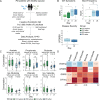A prebiotic dietary pilot intervention restores faecal metabolites and may be neuroprotective in Parkinson's Disease
- PMID: 40180909
- PMCID: PMC11968880
- DOI: 10.1038/s41531-025-00885-5
A prebiotic dietary pilot intervention restores faecal metabolites and may be neuroprotective in Parkinson's Disease
Abstract
Current treatment of Parkinson's Disease (PD) remains symptomatic, and disease-modifying approaches are urgently required. A promising approach is to modify intestinal microbiota and key metabolites of bacterial fermentation: short-chain fatty acids (SCFA), which are decreased in PD. A prospective, controlled pilot study (DRKS00034528) was conducted on 11 couples (PD patient plus healthy spouse as control (CO)). Participants followed a 4-week diet rich in dietary fibre, including intake of the prebiotic Lactulose. Gut metagenomes, faecal and urinary metabolites, and clinical characteristics were assessed. The dietary intervention significantly augmented faecal SCFA and increased Bifidobacteria spp., reducing PD-related gastrointestinal symptoms. The pre-existing bacterial dysbiosis in PD (depletion of Blautia, Dorea, Erysipelatoclostridium) persisted. Bacterial metabolite composition in faeces and urine positively changed with the intervention: Brain-relevant gut metabolic functions involved in neuroprotective and antioxidant pathways, including S-adenosyl methionine, glutathione, and inositol, improved in PD. These promising results warrant further investigation in larger cohorts.
© 2025. The Author(s).
Conflict of interest statement
Competing interests: The authors declare no competing interests.
Figures




Similar articles
-
Prebiotic effects: metabolic and health benefits.Br J Nutr. 2010 Aug;104 Suppl 2:S1-63. doi: 10.1017/S0007114510003363. Br J Nutr. 2010. PMID: 20920376 Review.
-
Gut Microbiota and Metabolome Alterations Associated with Parkinson's Disease.mSystems. 2020 Sep 15;5(5):e00561-20. doi: 10.1128/mSystems.00561-20. mSystems. 2020. PMID: 32934117 Free PMC article.
-
The effect of supplementation with prebiotic fiber on the gut microbiota of a group of older people with Parkinson's disease from the city of Santiago de Chile. A pilot study.Nutr Hosp. 2025 Apr 21;42(2):232-242. doi: 10.20960/nh.05272. Nutr Hosp. 2025. PMID: 40008668 English.
-
Habitual dietary fibre intake influences gut microbiota response to an inulin-type fructan prebiotic: a randomised, double-blind, placebo-controlled, cross-over, human intervention study.Br J Nutr. 2018 Jan;119(2):176-189. doi: 10.1017/S0007114517003440. Epub 2018 Jan 8. Br J Nutr. 2018. PMID: 29307330 Clinical Trial.
-
Dietary glycation compounds - implications for human health.Crit Rev Toxicol. 2024 Sep;54(8):485-617. doi: 10.1080/10408444.2024.2362985. Epub 2024 Aug 16. Crit Rev Toxicol. 2024. PMID: 39150724
Cited by
-
Role of the microbiota in inflammation-related related psychiatric disorders.Front Immunol. 2025 Aug 20;16:1613027. doi: 10.3389/fimmu.2025.1613027. eCollection 2025. Front Immunol. 2025. PMID: 40909294 Free PMC article. Review.
-
The Small Intestinal Microbiota and the Gut-Brain Axis in Parkinson's Disease: A Narrative Review.Biomedicines. 2025 Jul 19;13(7):1769. doi: 10.3390/biomedicines13071769. Biomedicines. 2025. PMID: 40722839 Free PMC article. Review.
-
Therapeutic Horizons: Gut Microbiome, Neuroinflammation, and Epigenetics in Neuropsychiatric Disorders.Cells. 2025 Jul 4;14(13):1027. doi: 10.3390/cells14131027. Cells. 2025. PMID: 40643545 Free PMC article. Review.
References
-
- Collins, S. M. & Bercik, P. The relationship between intestinal microbiota and the central nervous system in normal gastrointestinal function and disease. Gastroenterology136, 2003–2014, 10.1053/j.gastro.2009.01.075 (2009). - PubMed
-
- Spielman, L. J., Gibson, D. L. & Klegeris, A. Unhealthy gut, unhealthy brain: the role of the intestinal microbiota in neurodegenerative diseases. Neurochem. Int.120, 149–163, 10.1016/j.neuint.2018.08.005 (2018). - PubMed
-
- Bedarf, J. R., Hildebrand, F., Goeser, F., Bork, P. & Wüllner, U. Das Darmmikrobiom bei der Parkinson–Krankheit. Nervenarzt90, 160–166, 10.1007/s00115-018-0601-6 (2019). - PubMed
Grants and funding
LinkOut - more resources
Full Text Sources
Miscellaneous

